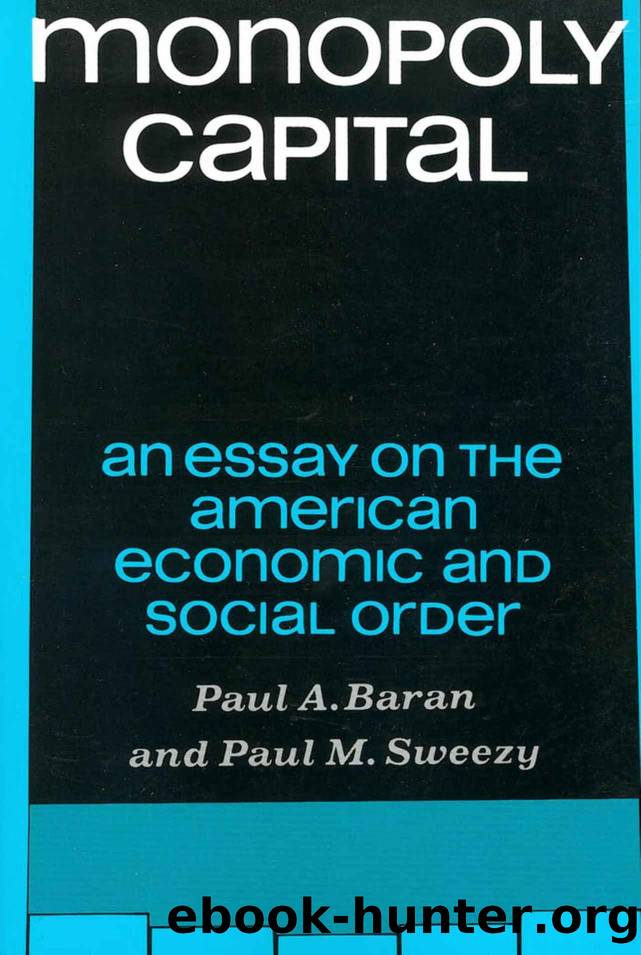Monopoly Capital by Paul A. Baran and Paul M. Sweezy

Author:Paul A. Baran and Paul M. Sweezy
Language: eng
Format: mobi
Publisher: MODERN READER PAPERBACKS
Published: 2020-07-23T16:00:00+00:00
6
This is of course not the only way the “free world” is being defended. The United States failed to understand the nature of the revolution which overthrew the Batista regime in Cuba until it was too late to keep the revolutionaries from consolidating their power. Every precaution is being taken to see that the same mistake is not made again. All revolutionaries are automatically suspect; no regime is too reactionary to merit allout United States backing.
Partly, this backing takes the form of so-called economic aid—in reality handouts to corrupt oligarchies designed to insure their loyalty to Washington rather than to the interests of their own countries.194 And partly it takes the form of military aid, which is predominantly of two types.
First, there is direct participation by United States armed forces on the territory of the client state: stationing of troops in bases controlled by the United States (as we saw above, there are some 275 major base complexes and 1,400 bases either occupied by or prepared for American forces); “emergency” deployment of troops anywhere on the host country’s national territory that the two governments may decide (Lebanon in the summer of 1958, Thailand in the spring of 1962, the Dominican Republic in the spring of 1965); and various kinds of advisory and training missions accredited to the armed forces of the clients (in 1957, a total of forty Army, Navy, and Air Force missions were in Latin America alone, in every country except Mexico). As South Vietnam shows, training missions can be quickly and almost imperceptibly transformed into counter-revolutionary combat forces.195
The second form of military aid is the provision of material and financial support for the armed forces of the client states. While the dozens of military assistance pacts which the United States has signed with underdeveloped countries around the world are ostensibly designed to meet the “threat” of aggression from the Soviet Union or China, no serious military planner imagines that this is the real purpose. Such a threat, if it really existed, could be countered only by the United States itself, and an attempt to coordinate military strategy with a large number of feeble allies would be a source of weakness rather than strength. The real purpose of this military aid is clearly spelled out by Lieuwen in his pioneer study of the role of the military in Latin America:
Those (military) policies … are not designed to meet the military threat of communism, but rather to gain Latin America’s friendship, to win its cooperation and support in the United Nations and the Organization of American States. The Rio military alliance, the M[utual] D[efense] Assistance] Pacts, the arms grants, the reimbursable aid, the work of the I[nter] A[merican] D[efense] B[oard) and of the military missions—all of these have no great military significance. They are designed, above all, to draw the Latin American officer corps, which exercise great influence over the political scene in most of the republics, closer to the United States, in the hope that they will exclude
Download
This site does not store any files on its server. We only index and link to content provided by other sites. Please contact the content providers to delete copyright contents if any and email us, we'll remove relevant links or contents immediately.
| Anarchism | Communism & Socialism |
| Conservatism & Liberalism | Democracy |
| Fascism | Libertarianism |
| Nationalism | Radicalism |
| Utopian |
The Secret History by Donna Tartt(16618)
The Social Justice Warrior Handbook by Lisa De Pasquale(11489)
Thirteen Reasons Why by Jay Asher(7786)
This Is How You Lose Her by Junot Diaz(5768)
Weapons of Math Destruction by Cathy O'Neil(5034)
Zero to One by Peter Thiel(4823)
The Myth of the Strong Leader by Archie Brown(4789)
Promise Me, Dad by Joe Biden(4444)
Stone's Rules by Roger Stone(4415)
Beartown by Fredrik Backman(4413)
How Democracies Die by Steven Levitsky & Daniel Ziblatt(4397)
The Fire Next Time by James Baldwin(4341)
100 Deadly Skills by Clint Emerson(4076)
A Higher Loyalty: Truth, Lies, and Leadership by James Comey(4031)
Rise and Kill First by Ronen Bergman(4012)
The David Icke Guide to the Global Conspiracy (and how to end it) by David Icke(3881)
The Farm by Tom Rob Smith(3871)
Secrecy World by Jake Bernstein(3782)
The Doomsday Machine by Daniel Ellsberg(3730)
